After Hare & Tortoise,
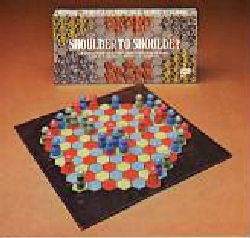
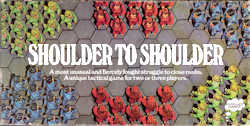 Shoulder to Shoulder was the second and only other game of mine to be published by
Intellect Games. I've always been fascinated by games for three players, and this is my favourite attempt
at devising a strategic board-game for that number (though it can also be played by
two if you can't find a third).
The aim is to be the first to get all the
pieces of your own colour together in a single connected group. It was published in 1975
by Intellect Games, who named it after a now long-forgotten television series about suffragettes.
I subsequently renamed it "Solidarnosc", then "Mob Rule", but have now become reconciled to
its original title. It's no longer in print, but I still get asked about it, so here's the definitive description.
Shoulder to Shoulder was the second and only other game of mine to be published by
Intellect Games. I've always been fascinated by games for three players, and this is my favourite attempt
at devising a strategic board-game for that number (though it can also be played by
two if you can't find a third).
The aim is to be the first to get all the
pieces of your own colour together in a single connected group. It was published in 1975
by Intellect Games, who named it after a now long-forgotten television series about suffragettes.
I subsequently renamed it "Solidarnosc", then "Mob Rule", but have now become reconciled to
its original title. It's no longer in print, but I still get asked about it, so here's the definitive description.
The board and set-up
The board (right)
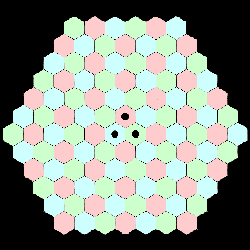 consists of 114 hexagonal cells, 38 each of red, green and blue.
The three central cells, one of each colour, are each marked with a spot and are referred to as home cells.
consists of 114 hexagonal cells, 38 each of red, green and blue.
The three central cells, one of each colour, are each marked with a spot and are referred to as home cells.
Three players,
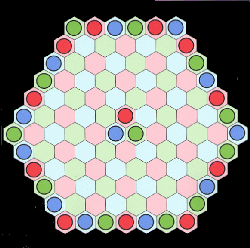 designated Red, Green and Blue, each have 12 pieces of their own colour. They start (left) by placing eleven of their pieces on the edge
cells of their own colour and the twelfth on the home cell of the same colour.
designated Red, Green and Blue, each have 12 pieces of their own colour. They start (left) by placing eleven of their pieces on the edge
cells of their own colour and the twelfth on the home cell of the same colour.
Object of the game
Your main aim is
 to get all your pieces together into a single connected group, so that each one lies edge-by-edge with at least one other of your own colour. The group may form a large area or a line, or a mixture of the two, so long as all its constituent pieces are connected. In this example (right), Red has just "connected" and play immediately ceases.
to get all your pieces together into a single connected group, so that each one lies edge-by-edge with at least one other of your own colour. The group may form a large area or a line, or a mixture of the two, so long as all its constituent pieces are connected. In this example (right), Red has just "connected" and play immediately ceases.
A secondary object, in case of failure, is to ensure that your own pieces form as few connected groups as possible (for which purpose a single unconnected piece counts as a group). The winner scores zero penalties and each opponent scores one penalty for each distinct group formed by their own pieces. The minimum penalty score is therefore normally two. However, a player who at end of play is only one move away from forming a single connected group scores only one penalty instead of two. In this example, Green counts three penalty points and Blue four, while Red counts none.
A match is three games, and the ultimate winner is the player with the lowest penalty score at the end of the third game.
Movement
Red moves first
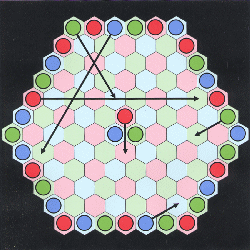 in the first game, Green in the second, and Blue in the third. The order of play within in each game is always Red, Green, Blue.
in the first game, Green in the second, and Blue in the third. The order of play within in each game is always Red, Green, Blue.
At each turn you move any one of your own pieces. There are two different types of move: the straight and the squeeze.
A straight move is one that follows a straight line, crossing at right angles over the edges of adjacent cells. You may move your piece one or more spaces across any distance, so long as it does not land on or jump over another piece of any colour. You may end the move on an unoccupied cell of any colour except for the home cell of either of your opponents. You may pass over an opponent's home cell if it is vacant, but the only one you can land on is your own. Three examples of straight moves are shown at top left of the diagram.
The squeeze is a short move that can only be made by a piece occupying a cell of your own colour. In this case you can move it to any one of the nearest vacant cells of the same colour (your own), by making it exit from one corner of the cell and travel along a single edge until it reaches the next cell of the same colour. This move is called a squeeze because it may be made even when either or both of the cells it passes between are occupied by a piece or pieces of any colour, so that it is forced to squeeze between them. Three examples of squeezes are shown in the diagram above. Note how the red piece on its home cell squeezes between a blue and a green.
Play continues until one player has connected. No more moves may then be made.
The two-player game
This (right)
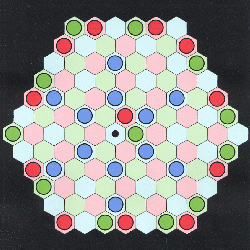 is how the board is set up if only two are playing. The 12 pieces of the third colour (in this case blue) are arranged as
shown, with two each radiating in all six directions from the home cell of that colour. The unused home cell is left empty. Follow all th
rules of the three-player game but with these exceptions:
is how the board is set up if only two are playing. The 12 pieces of the third colour (in this case blue) are arranged as
shown, with two each radiating in all six directions from the home cell of that colour. The unused home cell is left empty. Follow all th
rules of the three-player game but with these exceptions:
(a) You may not move any pieces of the third colour - their purpose is merely to act as hindrances.
(b)You may not land on or pass over the home cell of the third colour.
